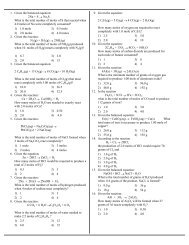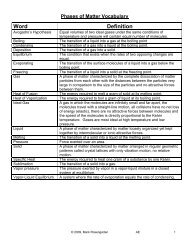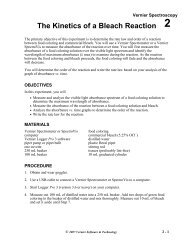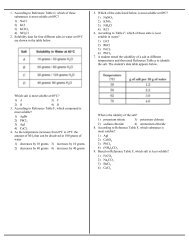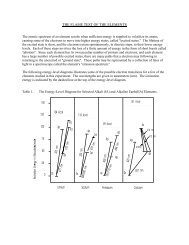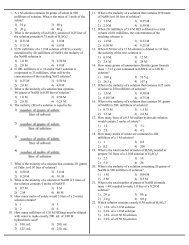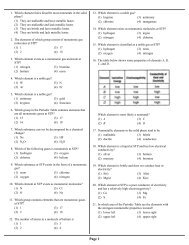Kinetics, Thermodynamics and Equilibrium - Revsworld
Kinetics, Thermodynamics and Equilibrium - Revsworld
Kinetics, Thermodynamics and Equilibrium - Revsworld
Create successful ePaper yourself
Turn your PDF publications into a flip-book with our unique Google optimized e-Paper software.
2) Solution <strong>Equilibrium</strong>: formed when a solution is saturated. The rate of dissolving equals the rate of<br />
precipitating.<br />
NaCl (s) Na +1 (aq) + Cl -1 (aq)<br />
When sodium chloride is first placed in the water, the salt dissolves. As the concentration of dissolved ions increases,<br />
some of those dissolved ions will rejoin each other <strong>and</strong> form a precipitate, which is almost immediately re-dissolved.<br />
Eventually, all of the water molecules will be engaged in holding ions apart <strong>and</strong> no more salt can go into solution until<br />
some ions come out of solution as precipitate. The rate of dissolving equals the rate of precipitating. This is called a<br />
saturated solution. If you place a salt cube in a beaker of saturated sodium chloride solution, the cube will change<br />
shape over time as ions precipitate onto the cube from solution as salt from the cube dissolves. This demonstrates<br />
very well the dynamicity of systems at equilibrium.<br />
Dissociation Of Electrolytes (M = metal, A = nonmetal that forms anion)<br />
MA (s) M + (aq) + A - (aq)<br />
M 2 A (s) 2 M + (aq) + A -2 (aq)<br />
MA 2 (s) M +2 (aq) + 2 A - (aq)<br />
MA (s) M +2 (aq) + A -2 (aq)<br />
M 2 A 3 (s) 2 M +3 (aq) + 3 A -2 (aq)<br />
Where the (s) reactants represent the undissolved solid that sits at the bottom of the container <strong>and</strong> the ions on the<br />
product side represent the dissolved ions in solution.<br />
NaCl (s) Na +1 (aq) + Cl -1 (aq)<br />
K eq = [Na +1 ] [Cl -1 ] / [NaCl]<br />
Li 2 SO4 (s) 2 Li +1 (aq) + SO 4 -2 (aq) K eq = [Li +1 ] 2 [SO 4 -2 ] / [Li 2 SO 4 ]<br />
Mg(NO 3 ) 2 (s) Mg +2 (aq) + 2 NO 3 -1 (aq) Keq = [Mg +2 ] [NO 3 -1 ] 2 / [Mg(NO 3 ) 2 ]<br />
The higher the Keq for the dissolving is, the more product that is formed <strong>and</strong> therefore the more ions that are dissolved<br />
in the solvent the higher the solubility.<br />
SOLUBILITY PRODUCT CONSTANT<br />
Some salts have very strong interionic attractions, <strong>and</strong> it takes a lot of solvent molecules to break them apart. For<br />
these solutions, solution equilibrium is established at a low concentration of dissolved ions. The concentration is so<br />
small that the change is insignificant when compared to the concentration of undissolved solid. If we allowed this to<br />
happen, the K eq of all salts of this type (called mostly insoluble) would = 0. Since this would be of no use to us in<br />
comparing relative solubilities of these mostly insoluble salts. Instead, we use the equilibrium constant K sp , the<br />
solubility product constant. This constant consists of the concentrations of the dissolved ions, <strong>and</strong> is used for<br />
comparing the relative solubilities of mostly insoluble salts. The concentration of undissolved salt is ignored.<br />
K sp = [M + ] [A - ]<br />
AgCl (s) Ag +1 (aq) + Cl -1 (aq) K sp = [Ag +1 ] [Cl -1 ]<br />
Li 2 CO 3 (s) 2 Li +1 (aq) + CO 3 -2 (aq) K sp = [Li +1 ] 2 [CO 3 -2 ]<br />
© 2009, Mark Rosengarten AE 12






